Technicians work inside the Orion crew module being built at Kennedy Space Center to prepare it for its first power on. Turning the avionics system inside the capsule on for the first time marks a major milestone in Orion’s final year of preparations before its first mission, Exploration Flight Test 1. Credit: Lockheed Martin
Story and imagery updated[/caption]
KENNEDY SPACE CENTER, FL – Orion, the first NASA spaceship that will ever carry Earthlings to deep space destinations, has at last been “powered on” for the first time at the manufacturing facility at the Kennedy Space Center (KSC) where it’s the centerpiece of a beehive humming 24/7 with hi tech processing activities in all directions.
“Power On” marks a major milestone ahead of the maiden space bound Orion test flight dubbed “EFT-1” – now at T-Minus 1 year and counting!
NASA and prime contractor Lockheed Martin recently granted Universe Today an exclusive in depth inspection tour of the impressive Orion EFT-1 crew module, service module and associated hardware destined for the crucial unmanned test flight slated for liftoff from Cape Canaveral in September 2014.
“We are moving fast!” said Jules Schneider, Orion Project manager for Lockheed Martin at KSC, during an exclusive interview with Universe Today as we spoke beside the Orion EFT-1 spacecraft inside the clean room.
“We are bringing Orion to life. Lots of flight hardware has now been installed.”

“We are working 24 hours a day, 7 days a week,” Schneider told me.
Some 200 people are actively employed on building Orion by Lockheed Martin at the Kennedy Space Center.
“There are many significant Orion assembly events ongoing this year,” said Larry Price, Orion deputy program manager at Lockheed Martin, in an interview with Universe Today at Lockheed Space Systems in Denver.
“This includes the heat shield construction and attachment, power on, installing the plumbing for the environmental and reaction control system, completely outfitting the crew module, attached the tiles, building the service module and finally mating the crew and service modules (CM & SM),” Price told me.
Orion is a state of the art crew capsule that will ultimately enable astronauts to fly to deep space destinations including the Moon, Asteroids, Mars and beyond – throughout our solar system.
And Universe Today has had a front row seat.
I have been very fortunate to periodically visit Orion up close over the past year and half to evaluate the testing and assembly progress inside the Operations and Checkout Building at KSC where the vehicle is now rapidly coming together, since the bare bones pressure vessel arrived to great fanfare in June 2012.
For the first time Orion looked to my eyes like a real spaceship, rather than the backbone shell outfitted with hundreds of important test harnesses, strain gauges and wiring to evaluate its physical and structural integrity.
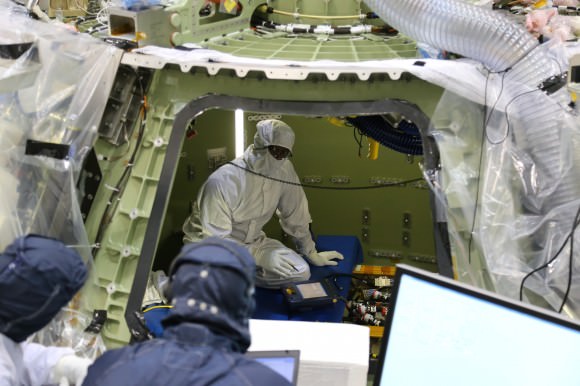
Engineers and technicians at KSC have removed the initial pressure testing gear and are now installing all the flight systems and equipment – such as avionics, instrumentation, flight computers, thrusters, wiring, plumbing, heat shield and much more – required to transform the initial empty shell into a fully functioning spacecraft.
“The Orion skeleton was here before. Now we are putting in all of the other systems,” Schneider explained to me.
“We are really busy.”
“So far over 66,000 Orion parts have been shipped to KSC from over 40 US states,” Price explained.
The heat shield was due to arrive soon and technicians were drilling its attachment ring holes as I observed the work in progress.
“The propulsion, environmental control and life support systems are now about 90% in. The ammonia and propylene glycol loops for the thermal control system are in. Many of the flight harnesses are installed.”
“All of the reaction control thrusters are in – fueled by hydrazine – as well as the two hydrazine tanks and a helium tank. Altogether there are 12 hydrazine pods with two thrusters each,” Schneider elaborated.
The power distribution unit (PDU) – which basically functions as Orion’s computer brains – was installed just prior to my visit. All four PDU’s – which issue commands to the vehicle – were built by Honeywell.
Technicians were actively installing fiber optic and coaxial cables as I watched. They also were conducting leak tests on the environmental control coolant (ECLS) systems which had to be completed before the ‘power on’ testing could begin – in order to cool the avionics systems.
Thermal protection system (TPS) tiles were being bonded to the back panels which ring Orion. The TPS panels get attached early in 2014.
“This is real stuff,” said Schneider gleefully.
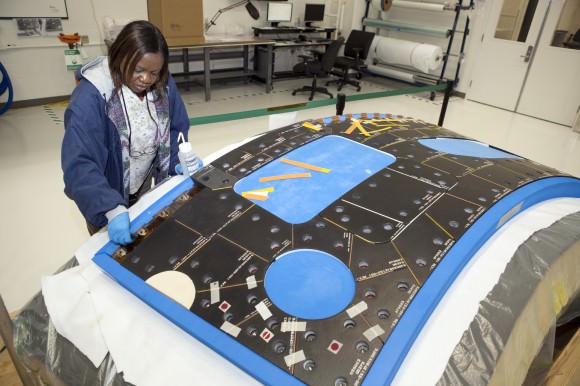
NASA says that “the preliminary data indicate Orion’s vehicle management computer, as well as its innovative power and data distribution system — which use state-of-the-art networking capabilities — performed as expected” during the initial crew module power on.
About two months or so of power on functional testing of various systems will follow.
Just like the configuration used in the Apollo era, the Orion crew module will sit atop a service module – and that work is likewise moving along at a rapid clip.
“The Orion service module (SM) is also almost complete,” Schneider said as he showed me the service module structure.
“Structurally the SM is 90% done. The active thermal control system is in and all the fluid systems are welded in and pressure tested.”
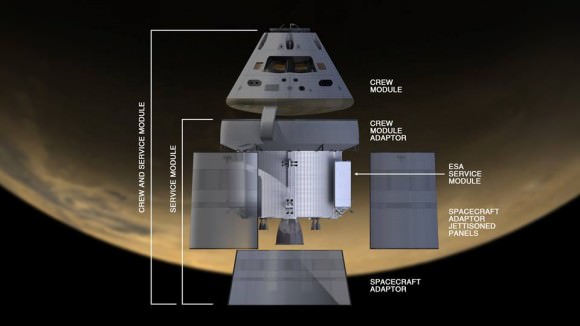
Orion EFT-1 will blastoff atop a mammoth United Launch Alliance Delta IV Heavy rocket – the most powerful booster in America’s arsenal since the shuttle’s retirement in 2011.
The crew module and service module (CM/SM) will be mated inside the O&C and then be placed onto a mission adapter that eventually attaches to the top of the Delta IV Heavy booster.
They will be mated at the exact same spot in the O&C Building where the Apollo era command and service modules were stacked four decades ago.
Currently, the schedule calls for the Orion CM/SM stack to roll out to Kennedy’s Payload Hazardous Services Facility (PHSF) for servicing and fueling late this year, said Larry Price.
After that the CM/SM stack is transported to the nearby Launch Abort System Facility (LASF) for mating to the emergency Launch Abort System (LAS).
All that work could be done around March 2014 so that ground operations preparing for launch can commence, according to Price.
“In March 2014 we’ll be ready for ground ops. The normal launch processing flow starts in June 2014 leading to Orion’s launch from pad 37 in September 2014.”
“It’s very exciting and a tribute to the NASA and contractor teams,” Price said.
The 2014 uncrewed flight will be loaded with a wide variety of instruments to evaluate how the spacecraft behaves during launch, in space and then through the searing heat of reentry.
The two-orbit, four- hour flight will lift the Orion spacecraft and its attached second stage to an orbital altitude of 3,600 miles, about 15 times higher than the International Space Station (ISS) – and farther than any human spacecraft has journeyed in 40 years.
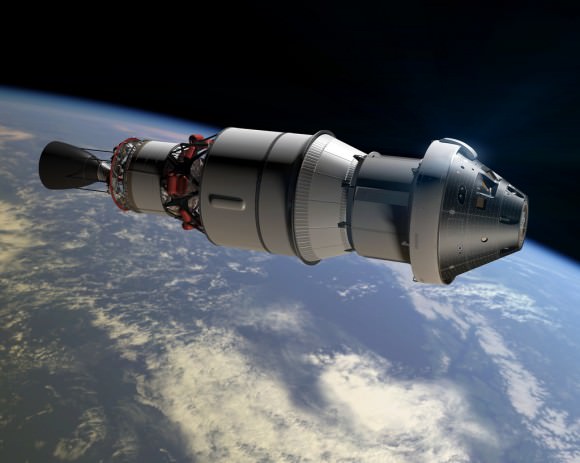
Although the mission will only last a few hours it will be high enough to send the vehicle plunging back into the atmosphere and a Pacific Ocean splashdown to test the craft and its heat shield at deep-space reentry speeds of 20,000 mph and endure temperatures of 4,000 degrees Fahrenheit – like those of the Apollo moon landing missions.
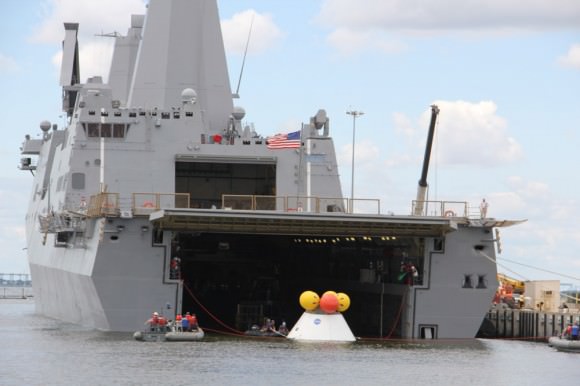
The EFT-1 mission will provide engineers with critical data about Orion’s heat shield, flight systems and capabilities to validate designs of the spacecraft, inform design decisions, validate existing computer models and guide new approaches to space systems development. All these measurements will aid in reducing the risks and costs of subsequent Orion flights before it begins carrying humans to new destinations in the solar system.
“The Orion hardware and the Delta IV Heavy booster for the EFT-1 launch are on target for launch in 2014,” Scott Wilson, NASA’s Orion Manager of Production Operations, told Universe Today in an interview.
…………….
Learn more about Orion, MAVEN, Mars rovers and more at Ken’s upcoming presentations
Nov 14-19: “MAVEN Mars Launch and Curiosity Explores Mars, Orion and NASA’s Future”, Kennedy Space Center Quality Inn, Titusville, FL, 8 PM
Dec 11: “Curiosity, MAVEN and the Search for Life on Mars”, “LADEE & Antares ISS Launches from Virginia”, Rittenhouse Astronomical Society, Franklin Institute, Phila, PA, 8 PM
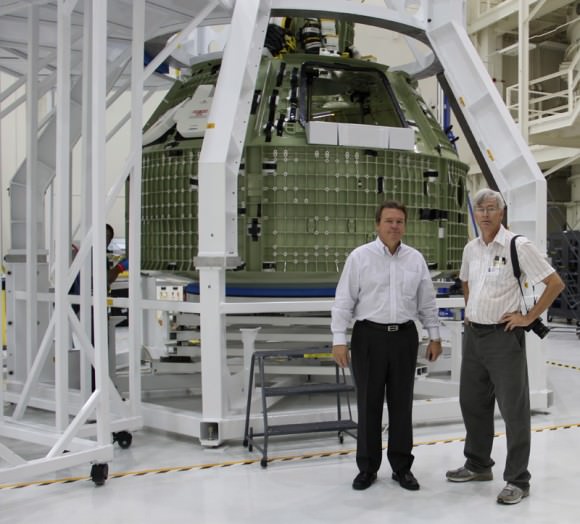

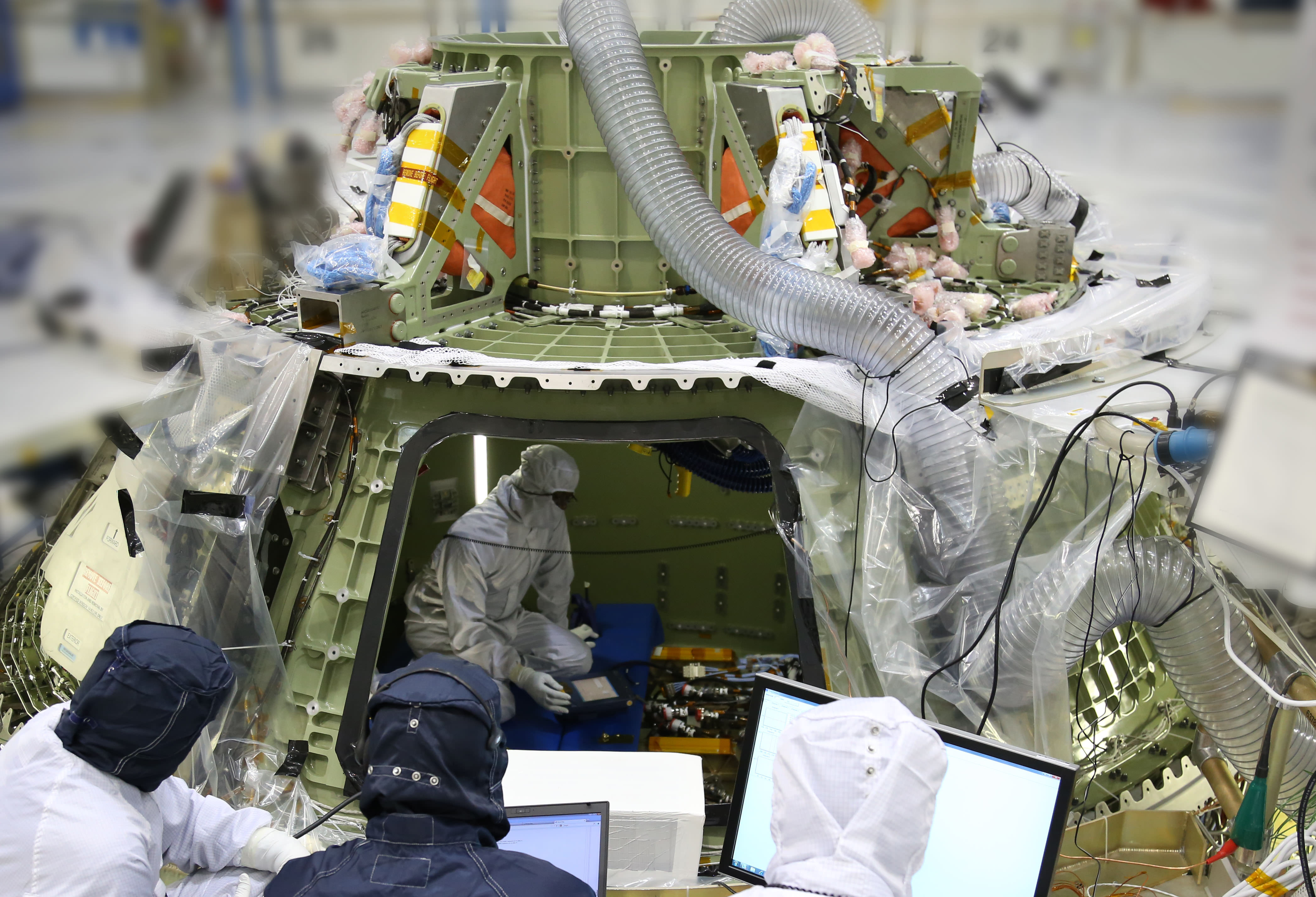
Amazing! I look forward to watching this as I think many of us miss watching the launches at KSC and continuing space exploration.
Of course, this is fantastic news.
What a shame that all this effort will essentially be made to reproduce the capabilities of manned flight developed almost 50 years ago.
The only thing that is the same as Apollo is the shape of the capsule.
That is it. All the rest is completely new technology.
This is a deep space orbiter. Wings are just dead-weight when you go deep-space.
You miss the point completely. Which is odd, because it’s pretty obvious.
What is obvious?
The technology is new and different, granted. But will it ultimately *do* anything new and different with it?
Currently,
it appears the only missions we can have any certainty of (asteroid
retrieval is not yet certain at all), are Lunar orbit flights that won’t
do much more than Apollo 8 did, except for somewhat longer possible
orbital stay times.
If it were at least possible to do high
inclination Lunar orbits with Orion/SLS to have multiple opportunities
to examine the polar regions from above with instruments, that would be
nice, But I’ve heard nothing to that effect, either.
OK I thought we you commenting on the shape that it looked like Apollo.
Yes the missions are missing. And I hope hey find new missions. But building the space crafts is needed, and could be used for experiments humans when they are on deep space missions.
It could become the start of building blocks of a Mars mission. They could put then required parts in orbit around the moon, reducing the required mass of the rocket because it needs less powerful rockets.
There are limits to what this capsule could do, however — and its capabilities are likely to be matched or surpassed by those of the Dragon capsule within a few years. More importantly, Dragon will have new capabilities like the ability to propulsively land on the Moon or Mars and abort capabilities all the way to LEO (far exceeding the flexibility of Orion’s launch abort system). It seems rather pointless to spend all this money on something whose primary mission seems to be orbiting the Moon.
Good to see Orion’s continuing progress! Thanks Ken…
Alternately, what progress is happening with the man-rated Dragon capsule from SpaceX? Who will be the first to actually fly astronauts? Boeing, Space X or Sierra Nevada?
Thanks
I hope to have another SpaceX update soon. 1st Astros likely to fly on SpaceX or Boeing. but stupid sequester budget cuts are delaying many NASA programs
LOL! Yassir! “…stupid sequester budget cuts…” does strike the nail smack dab on the head! In this case, I like what Dr. Hunter S. Thompson said, “When the going gets weird, the weird turn pro!”
and don’t forget the “regular yearly congressional NASA budget cuts” that already delayed commercial crew by about 4 years or so. both Orion and commercial crew could have flown by 2013/2014 time frame otherwise – that’s for another story
Yes, congress appears to have an attitude of curmudgeoning lassitude. Soon only the wealthy will be able to afford an education or food for their table? Followed by this warning… BE CAREFUL! You can only push us so far… and we are getting hungry.
But the Dragon is not intended for deep-space.
Deep-space capsules will be more expensive when it has less dependency on ground control, including additional time delays. It must also be more reliable and delivers long duration environmental controls.
It is interesting that people always thinks that manned space crafts are completely autonomous. But they are not. They have to rely on telemetry data to guide them to their target and back towards Earth. Even though the space crafts is in space, it is strapped to a massive powerful computer here at Earth to guide its trajectory. Humans are only hitching a ride.
I guess that depends upon your definition of “deep space.”
Dragon is intended at some point in time to make the trip to the moon and later than that Mars. Elon Musk has said as much on numerous occasions.
You may have a point if you are referring to going to the asteroid belt and beyond. I’d give 10 to 1 odds Orion never makes their either although theoretically it was intended to reach that far.
yes agreed. well don’t forget MAVEN launches on Nov 18 and I’ll be there for Universe Today. read my articles
I’m rereading a book on the history of the Apollo program, and that brings me to a question – how does the toilet work on the Orion? I know it’s bigger than the Apollo Command Module, but I don’t see how they can put a private bathroom in, nor do I see them returning to fecal bags that the Apollo astronauts hated so much.
What is the current & projected development cost for Orion? What is the expected recurring cost to build each new Orion? Is any substantive cost control even an objective?
“enable astronauts to fly to deep space destinations including the Moon, Asteroids, Mars and beyond” … who are we kidding? You can’t stick a crew in something like that for months at a time and without a Lander, what’s the point of going back to the Moon? Face it, Orion is a regurgitation of techniques used since Gemini and is designed for ONE thing, taking a crew to Lunar orbit and returning them safely to Earth. Been there, done that, got a tee-shirt.
Brings back memories of the moon race and all the incremental space flights that eventually led to our landing on the moon and returning safely. This is going deeper than the moon landing. It’s technology for way more distant explorations.